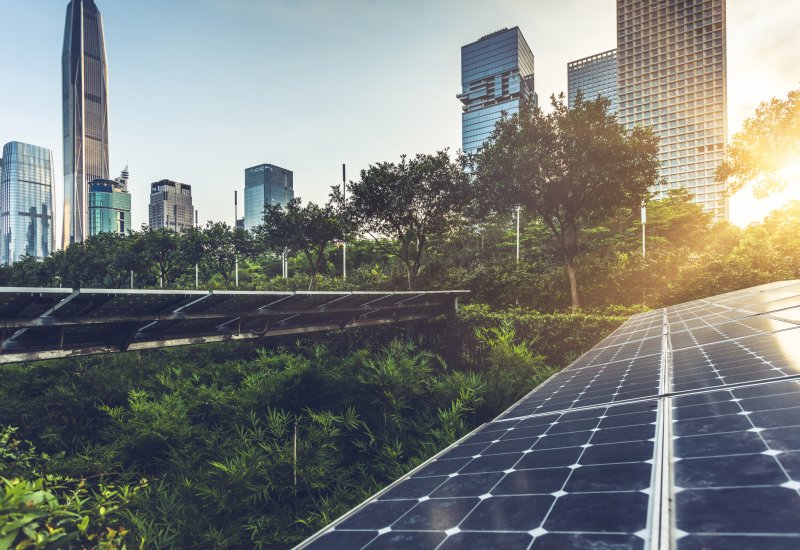
A word with our expert on green bonds
- 10 May 2022 (5 min read)
‘The green bond universe is an attractive alternative to conventional debt’
Provided they are carefully selected, green bonds have major advantages for a responsible investor, not only for their positive impact on climate change but also from an investment returns perspective. Johann Plé, a fixed income manager at AXA IM, sheds light on the current challenges and opportunities in this fast-growing market.
Why is the green bond market developing so fast?
This corresponds to a growing awareness of the climate emergency, embodied in the multiple commitments of both issuers and investors to carbon neutrality. It is also a response to pressure from regulators who now often require companies to report on climate efforts.
Green bonds are an ideal instrument because they allow issuers to identify specific projects to which investors can explicitly allocate their capital. Increased transparency on the use of funds is also a real advantage over conventional obligations. For investors, this is a way to reduce their risks and seize opportunities. It requires them to select green bonds based not only on the projects they finance, but also on the overall strategy of their issuers. In this way, investors avoid those most exposed to climate change and, instead, target those who are best able to take advantage of changing demand.
What are the advantages of this asset class in an allocation?
The green bond universe offers a balanced risk profile: half of it is made up of corporate issuers (compared to 25% in the traditional bond universe) and yet retains a relatively similar sensitivity to rates. The rally in rates and the widening of credit risk premiums seen in recent months make the green bond universe attractive compared to conventional bonds.
Between active and passive management, which should investors choose for this market?
I believe that active management is much more appropriate in the green bond market. Not all green bonds are equal and one should not invest indiscriminately across the universe. Otherwise, this would mean investing in issuers who have some green projects but have no desire to improve their climate profile. With active management, we can exclude this type of issuer. An example of where we do this is airports as they are seeking to put forward projects to improve their energy performance, but at the same time are continuing to expand and develop air transport. That would not make sense for a green investor.
In addition, it becomes possible to generate excess returns by actively managing the “greenium”. This refers to the slight price differential seen between green and conventional bonds of the same issuer, due to the strong demand for green bonds. This premium, while low, varies significantly over time. For German 10 year debt, for example, it went from 1 basis point (bps) to issue at 7 bps before returning to 5 bps1 . An active manager can exploit this dynamic.
What innovations have you brought to your offering?
Some green bond investors are looking for yield and unconstrained duration management. We have, therefore, launched a more concentrated strategy that focuses on high yield and emerging issuers as there is now an increasing number of green bond issues in these sectors. Alongside this, flexible duration management allows us to navigate through market cycles.
We have also created a strategy on social bonds, which targets issues such as job preservation and access to education. Although this market has grown strongly during the Covid-19 crisis and is over EUR 320bn2 , it remains insufficiently diversified. Our strategy therefore also invests in sustainability bonds (which combine environmental and social projects) and - up to 25% - in conventional bonds from issuers who are well positioned for sustainable development objectives.
- U291cmNlOiAyOCBGZWJydWFyeSAyMDIyLCBBWEEgSU0vQmxvb21iZXJn
- U291cmNlIDMwIEFwcmlsIDIwMjIsIEJsb29tYmVyZw==

What are green bonds?
Green and social impact investing involves purchasing bonds where the proceeds are earmarked for projects which support a low-carbon economy or the basic needs of underserved populations and communities.
Find out moreDisclaimer
This document is for informational purposes only and does not constitute investment research or financial analysis relating to transactions in financial instruments as per MIF Directive (2014/65/EU), nor does it constitute on the part of AXA Investment Managers or its affiliated companies an offer to buy or sell any investments, products or services, and should not be considered as solicitation or investment, legal or tax advice, a recommendation for an investment strategy or a personalized recommendation to buy or sell securities.
Due to its simplification, this document is partial and opinions, estimates and forecasts herein are subjective and subject to change without notice. There is no guarantee forecasts made will come to pass. Data, figures, declarations, analysis, predictions and other information in this document is provided based on our state of knowledge at the time of creation of this document. Whilst every care is taken, no representation or warranty (including liability towards third parties), express or implied, is made as to the accuracy, reliability or completeness of the information contained herein. Reliance upon information in this material is at the sole discretion of the recipient. This material does not contain sufficient information to support an investment decision.
Issued in the U.K. by AXA Investment Managers UK Limited, which is authorised and regulated by the Financial Conduct Authority in the U.K. Registered in England and Wales, No: 01431068. Registered Office: 22 Bishopsgate, London, EC2N 4BQ
In other jurisdictions, this document is issued by AXA Investment Managers SA’s affiliates in those countries.